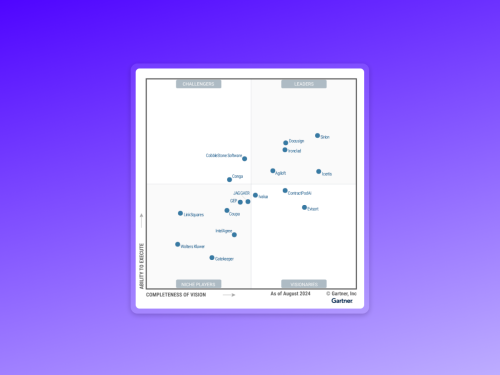
Navigating the LIBOR Transition with Speed, Accuracy and Compliance
Financial institutions can support the transition away from LIBOR with modern technologies like contract analytics and contract lifecycle management solutions.

Despite the economic disruption of COVID-19, the clock is still ticking toward the end of 2021, when cessation of the London Interbank Offered Rate (LIBOR) is slated to occur. LIBOR is the most commonly used benchmark interest rate across a wide range of financial products, including syndicated loans, consumer products, derivatives and securitizations. In a July 2020 webinar, John Williams, president of the Federal Reserve Bank of New York, said, “It doesn’t matter whether you’re a large global bank or a local company with a handful of employees, you need to be prepared to manage your institution’s transition away from LIBOR.”
From investment banks and credit unions to insurance carriers and corporate treasury departments, LIBOR impacts a range of institutions and shapes millions of financial contracts with an estimated global worth of $350T USD. In order to be prepared for LIBOR cessation, institutions must find all references to LIBOR in existing agreements and adapt these references to new overnight rates. Many institutions have commenced the gargantuan task of this transition and have progressed to varying degrees. However, they face persistent resource constraints and coordination challenges as they navigate toward the deadline. Combing through a haystack of agreements without the appropriate level of granularity and automated support will not only overwhelm resources and take time that institutions simply do not have, but will also create risk of errors, oversight and regulatory noncompliance. Satisfying regulators is particularly important as bodies like the OCIE announced their intent to formally examine firms’ LIBOR transition plans.
How contract management tools can expedite the LIBOR transition
Speed, accuracy and compliance are critical to an effective transition away from LIBOR. With contract analytics and contract lifecycle management (CLM) solutions as part of the Docusign Agreement Cloud (DAC), financial institutions can leverage modern technologies to support and scale the repapering process end-to-end. The following outlines a process we and Accenture use to help companies along this journey.
Step 1. Discover and analyze
Companies should first sift through thousands of contracts across multiple lines of business to identify LIBOR exposure. Docusign Insight can kickstart this process, validate current progress and assist in the remediation categorization of LIBOR-based agreements by using artificial intelligence to rapidly flag thousands of agreements and extract relevant clauses and information. Moreover, companies can leverage pretrained models, like the LIBOR Insight Accelerator, to recognize and mitigate LIBOR-related risk.
Step 2: Assess and amend
After flagging relevant contracts, companies need to identify their remediation path. Depending on the agreement type, the remediation path may be a simple notice to the borrower or a more complicated amendment to the terms of the agreement. Docusign CLM streamlines the remediation process by allowing institutions to efficiently route agreements through the appropriate workflows. For those agreements requiring amendment of terms, CLM’s clause library gives reviewers the ability to insert preapproved language and reduce the need for tedious back and forth with legal teams. The ability to nimbly adapt fallback provisions is particularly critical since ARRC continues to adjust its fallback language recommendations.
Step 3: Communicate and negotiate
Companies should then systematically route these agreements to relevant internal and external parties for negotiation and approval. With CLM, teams can configure flexible contract workflows then efficiently review and edit documents with full traceability. These capabilities are particularly helpful for complex agreements, like syndicated loan agreements, which involve multiple parties.
Step 4: Sign, book and store
Finally, organizations should fully execute the revised agreements. Docusign eSignature closes the loop by permitting signatures from almost any device and securely captures authorization and consent with a court-admissible audit trail.
Ultimately, these steps are cyclical and the remediation process is iterative. Institutions should continue to monitor trigger events for LIBOR-based contracts that are formed into mid-2021. They need to re-examine contracts per shifts in regulatory guidance and possible LIBOR-related legislation and recommendations. Additionally, events like Brexit and the recent overturn of the EU-US Data Privacy Shield require that companies be able to navigate and manage future waves of regulatory changes. With the Docusign Agreement Cloud, institutions can remain ever vigilant, informed and prepared.
Relationship with Accenture
Docusign has established an important working relationship with Accenture to provide companies with additional end-to-end coverage in the assessment, planning and execution phases of their LIBOR transformation. Drawing from an industry-tested playbook and its relationships with regulatory bodies and industry bodies, Accenture can help organizations:
Bring the right stakeholders to the table and consider downstream effects during impact assessments
Formulate a clear transition strategy, inclusive of product changes, client outreach, contract tranches and pricing
Execute clean changes, leveraging workflow technology for quality assurance throughout remediation, exposure dashboards for visibility and reporting, and interest rate calculators for automated updates
Wherever your company stands in the transition process, Docusign and Accenture can help. Interested in learning more about our joint solution? Register for the webinar “The End of LIBOR: Your navigation to a new normal” on October 14, 2020.
Related posts
Discover what's new with Docusign IAM or start with eSignature for free


